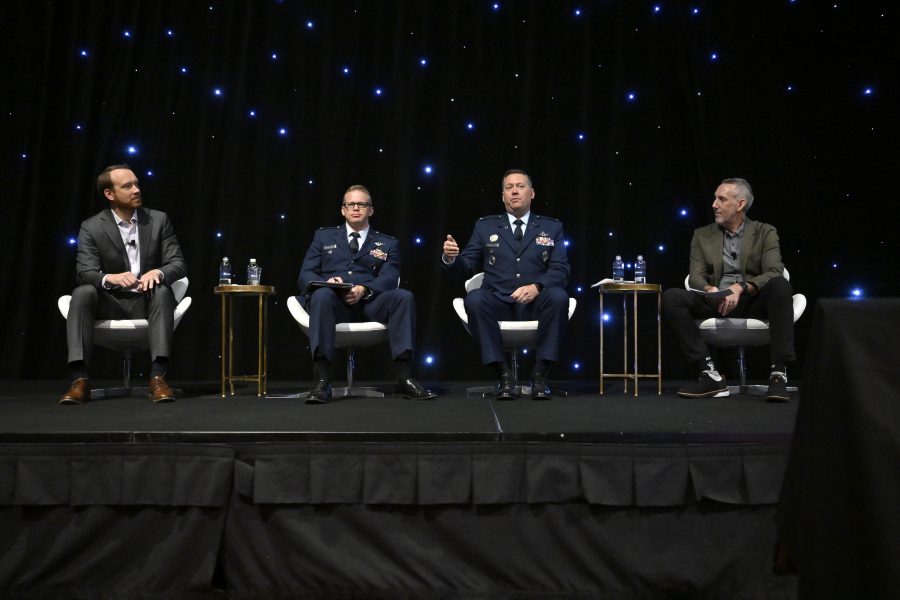LAS VEGAS—The traditional space traffic monitoring system for tracking satellites and debris circling the Earth, currently run by the Space Force, is under increasing strain because of the growing numbers of smaller satellites in orbit and growing threats.
One possible solution, showcased here at the ASCEND space conference, is a visual transponder—a tiny LED that means even a 10 cubic centimeter cubesat can be easily located and identified.
The Aerospace Corp., a federally funded research and development center, built such a transponder, called a “blinker,” using inexpensive off-the-shelf materials, and launched it in 2022 on an experimental cubesat dubbed Slingshot.
Blinker is one of several new STM technologies showcased at ASCEND, as the future of the mission has been thrown into turmoil. The Trump administration’s budget proposal for fiscal 2026 zeroes out funding for the effort, started under the first Trump administration, to transfer the STM mission from the Space Force’s Space Operations Command to the Office of Space Commerce in the National Oceanic and Atmospheric Administration, an independent regulatory agency within the Department of Commerce.
The Space Force conducts STM, also known as Space Situational Awareness or SSA, through its Space Surveillance Network, a capability that “is fairly robust,” said Mark Skinner, the senior project leader for space traffic management at the Aerospace Corp. “But as we increase the amount of space traffic, especially smaller objects [like cubesats] we end up with a very crowded and difficult situation for traditional purveyors of SSA.”

Skinner outlined a series of growing challenges faced by the traditional STM system, including “the COLA Gap” and “cubesat confusion.”
COLA stands for “Collision on Launch Assessment,” which is the mandatory risk assessment performed for new satellite launches, to check they won’t collide with existing satellites during their launch and separation. The COLA gap is the period of time between the end of the COLA (typically two hours after separation) and the time when the new satellite is cataloged by Space-Track.org, the Space Force’s publicly available database of tracked orbital objects. Depending on the orbit and other factors, the COLA gap can be several days.
Cubesat confusion occurs when multiple small satellites enter orbit from the same launch vehicle. Data aggregated by the Aerospace Corp. shows that up to 250 days after such a launch, as many as 20 percent of the satellites on such a launch remained uncatalogued.
The resources for space surveillance are limited, noted Skinner, “so if a number of [orbiting objects] can self-report on their state, then you can save those resources for things that really need it, the high-value assets that you care about.”
The SSA system that the Space Force’s Space Operations Command currently operates tracks 60,000 objects in orbit—including operational and decommissioned satellites, as well as larger orbital debris—and shares that data for free with allied governments and some commercial space operators, explained Col. Matthew Wroten, the global warfare requirements division chief of the capability and resource integration directorate of U.S. Space Command.
The Space Force currently has over 200 SSA information sharing agreements, Wroten said, about 30 with allied nations and the remainder with commercial space operators.
But that Space Surveillance Network was built for one mission, he added: ”The primary purpose was collision avoidance, and the assumption was predictability.”
In a world where space is a warfighting domain “there’s a different assumption, and that is that some actors and some satellites on orbit are trying to avoid detection,” said Wroten.
The move to transfer that collision avoidance mission to a civilian agency, begun seven years ago, was designed to “shift over [the STM mission] to a civilian organization, and free up the military to do military things,” said Col. Carl Bottolfson, director of futures and integration at the Space Force.
The significance of that shift, added Wroten, was underlined in 2021, when China tested a fractional orbital bombardment system, a weapon that launches itself into space and then dispatches hypersonic glide vehicles from orbit that descend to strike targets on Earth. “That demonstration event could have easily been a weapon that targeted the homeland,” he said.
The incident was a wakeup call for the Space Force, he said. “Think about the timelines needed to be able to respond to that,” he said, and the different detection technologies or phenomenologies required. “We don’t really have one phenomenology that can solve that whole flight, right?” Radar has “advantages and disadvantages. Passive [radio frequency detection] has advantages and disadvantages. … So we have to be able to fuse [data from] different phenomenology together to make the best use and to take advantage of the different strengths they have.”


